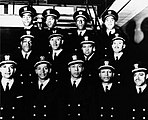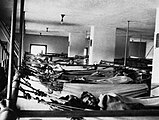USS Enterprise may refer to the following ships and other vessels:

Military recruit training, commonly known as basic training or boot camp, refers to the initial instruction of new military personnel. It is a physically and psychologically intensive process, which resocializes its subjects for the unique demands of military employment.

USS Triton (SSRN/SSN-586), the only member of her class, was a nuclear powered radar picket submarine in the United States Navy. She had the distinction of being the only Western submarine powered by two nuclear reactors. Triton was the second submarine and the fourth vessel of the United States Navy to be named for the Greek god Triton, At the time of her commissioning in 1959, Triton was the largest, most powerful, and most expensive submarine ever built at $109 million excluding the cost of nuclear fuel and reactors.

A drill instructor is a non-commissioned officer in the armed forces, fire department, or police forces with specific duties that vary by country. Foot drill, military step, and marching are typically taught by drill instructors.
The Basic Training Honor Graduate Ribbon is the informal collective name for three equivalent United States military awards for the Navy, Air Force, Space Force, and Coast Guard recruits who graduate at the top of their basic training classes: The Air Force Basic Military Training Honor Graduate Ribbon, the Coast Guard Basic Training Honor Graduate Ribbon, and the Navy Recruit Honor Graduate Ribbon.

Naval Station Great Lakes is the home of the United States Navy's only current boot camp, located near North Chicago, in Lake County, Illinois. Important tenant commands include the Recruit Training Command, Training Support Center and Navy Recruiting District Chicago. Naval Station Great Lakes is the largest military installation in Illinois and the largest training station in the Navy. The base has 1,153 buildings situated on 1,628 acres (6.59 km2) and has 69 mi (111 km) of roadway to provide access to the base's facilities. Within the naval service, it has several different nicknames, including "The Quarterdeck of the Navy", or the more derogatory "Great Mistakes". It is also referred to as "second boot camp" while at Training Support Command.

The United States Navy Reserve (USNR), known as the United States Naval Reserve from 1915 to 2005, is the Reserve Component (RC) of the United States Navy. Members of the Navy Reserve, called Reservists, are categorized as being in either the Selected Reserve (SELRES), the Training and Administration of the Reserve (TAR), the Individual Ready Reserve (IRR), or the Retired Reserve.
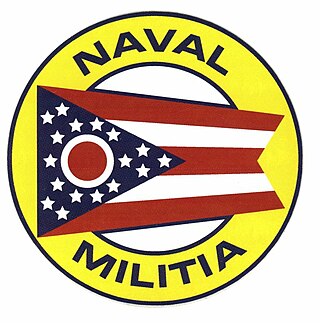
The Ohio Naval Militia (Ohio Navy) is the naval militia of the State of Ohio. It is the naval arm of the State of Ohio's Adjutant General's Department, and is part of Ohio's military forces.
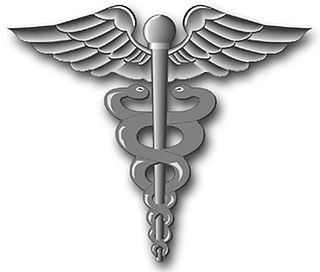
A hospital corpsman is an enlisted medical specialist of the United States Navy, who may also serve in a U.S. Marine Corps unit. The corresponding rating within the United States Coast Guard is health services technician (HS).
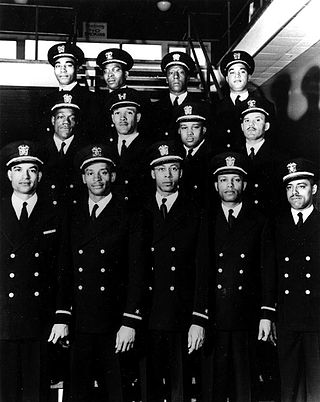
The Golden Thirteen were the thirteen African American enlisted men who became the first African American commissioned and warrant officers in the United States Navy.
Naval Hospital Corps School was the United States Navy's only basic hospital corpsman school. It was located within Lake County, Illinois, at 601 D St., Bldg 130H, Naval Station, Great Lakes, Illinois 60088, for nearly a century.

United States Naval Training Center Bainbridge was the U.S. Navy Training Center at Port Deposit, Maryland, on the bluffs of the northeast bank of the Susquehanna River. It was active from 1942 to 1976 under the Commander of the Fifth Naval District, based in Norfolk, Virginia.
James Sheldon was an officer in the United States Navy and a recipient of the Navy's second-highest decoration, the Navy Cross.

The yeoman rate is one of the oldest rates in the U.S. Navy, dating back to 1794. Historically, the Navy yeomen were responsible for keeping the storerooms for the ship's gunners, carpenters and boatswains. With the transition from sail to steam, yeomen were assigned to the ship's engineers. In the modern Navy, a yeoman is an enlisted service member who performs administrative and clerical work.

Naval Training Center San Diego (1923–1997) is a former United States Navy base located at the north end of San Diego Bay, commonly known as "boot camp". The Naval Training Center site is listed on the National Register of Historic Places, and many of the individual structures are designated as historic by the city of San Diego.
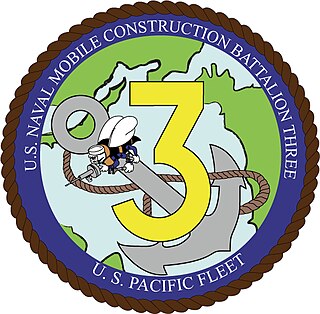
Naval Mobile Construction Battalion THREE is a United States Navy Seabee that was one of the three original Construction Battalions authorized to be formed in 1942. In May 1942 Naval Construction Battalion 3 deployed to the Territory of Hawaii and designated Brigade Headquarters Battalion for the Hawaiian Area NCF. After seeing service in the south Pacific,the battalion was decommissioned mid-1944. In 1950 the battalion was reactivated and today is home-ported at Port Hueneme, California.

The National Museum of the American Sailor is one of 10 Navy Museums that are operated by the Naval History & Heritage Command. As an official Department of the Navy Museum, the National Museum of the American Sailor's mission is to select, collect, preserve, and interpret the history of the United States Navy with particular emphasis on the Navy's enlisted Sailor. The National Museum of the American Sailor seeks to fulfill this mission by:
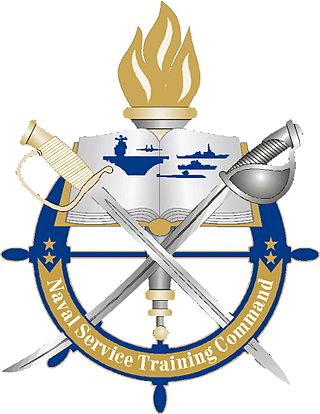
The Naval Service Training Command (NSTC) is a one-star Echelon III command of the United States Navy that is responsible to the Chief of Naval Education and Training for the indoctrination and training of all new accessions into the Naval Service, with the exception of Midshipmen who access through the United States Naval Academy. This includes all new recruits through Recruit Training Command, the Navy's only enlisted recruit training location and all Officer "Candidates" who are seeking a commission through the Officer Training Command at Naval Station Newport, Rhode Island. Also under its purview is the operation of the various Naval Reserve Officers Training Corps (NROTC) units in universities across the country.


